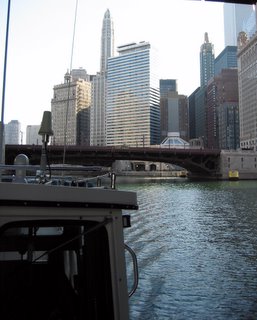
A boat is an outstanding place to ponder, at least when not crouching in the bilge covered in oil. It is my idea of an artist colony for one. Similar to institutions that sponsor artists in stately old mansions high in the mountains or in the flinty woods of the northeast, allowing them pursue their work isolated from life’s mundane tasks.
Of course, on the boat I have provided myself with a grant to sit and look out of the pilothouse. No one has to recognize my talent, and I do not have to submit a portfolio for anonymous judges to review. Just sitting and looking is my preoccupation, and while on the water simple things become important. Things like the surface of the water.
Nestled in the harbor wavelets predominate my visual field. The lake requires attention to Mother Nature: wind, water, clouds and waves. It requires all my concentration for navigation and for monitoring the fickle weather. These tasks become the preoccupation when underway. There is seldom time for contemplation.
The harbor relieves me of such duties and allows me to think about smaller, dare I say more inconsequential details. A harbor is a refuge that tempers the weather and lulls us into complacency. This is lost on many new boaters, drawing them out into uncomfortable, even dangerous encounters with the lake.
In my early days of boating and occasionally even now, when passing the red and green towers demarcating the harbor from the lake; if the weather is foul a sick feeling in my gut brings the realization that I should have never ventured out in the first place. And to make matters worst, once out it can take an agonizingly long time to get safely back and snug in your slip. Believe me when I say this, it is from hard won experience.
My point here is the minutiae of every day life, the things that make up the environment we become habituated to. As I sit, absorbed in the scene at the end of a long boating season, the surface of the water is disturbed by steady droplets of rain, by diving gulls, alighting Canadian geese and preening mallards, and by the death throws of the last few remaining salmon.
Wavelets radiate out from the nidus of raindrops in two groups of perfect concentric circles. The circles interact with the other ringlets created by the chilling October rain and intersect with waves generated from strong northeast winds and from the wakes of the few craft that still reluctantly ply the increasingly cold water.
The infinite variation, mind boggling as it is, follows physical principle and I am sure a physics professor has written equations to explain the phenomena. For me the changing nature of the universe is reflected on the surface of the water. It makes plausible the cliché that monarchs flapping their wings in the Yucatan can change the path of a hurricane.
Because of my interest in Japanese culture, especially chanoyu the tea ceremony, I take for granted that all this detail is not to be taken for granted. Nothing is as simple as it appears and everyday, even every second, is our last never to be repeated.
If it were a bright and sunny day my musings would take on a different tone. But today with winter, and the isolation that it brings not far away, these ponderings open up a rich world of experience that is always at our backdoor, but usually ignored in favor of images provided by the travel channel.
It makes searching for paradise in far-flung places unnecessary and relieves me of the burden of expectations. Things are just what they are…glorious, whether sitting in the pilothouse on a cold raining fall day, shoveling snow in my alley on Talman Avenue or walking amongst the graves under a canopy of ancient cedars on Mt. Koya-san.
